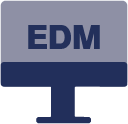 The Electronic Medical Documentation (EDM)
The Electronic Medical Documentation (EDM)
• eMedical Certificates.
Thanks to the EDM module, there is no need to log in to the eZLA system through a web browser. Simply add the eZLA tab to the visit management panel. Patient data in the sick leave form automatically populate.
The Electronic Medical Documentation (EDM) module is divided into three main components:
- ePrescriptions,
- eReferrals,
- eMedical Certificates.
 IRIS Schedule
IRIS Schedule
IRIS Schedule is a module that improves the work of registration staff. Registration work will be more effective and the handlingd time for a single patient will be shorter.
Thanks to the Schedule, it is possible to manage the schedule of appointments for a given office, as well as separately for each specialist.
The intuitive search function allows for quickly finding a convenient date for the patient.
The integration of the Schedule module with the SMS module will further improve the level of patient service at the facility thanks to sent reminders.
 IRIS Assistant
IRIS Assistant
IRIS Assistant is a module created for people who help doctors conduct a visit or prepare a patient for a procedure.
Access to individual patient data and the functions of the Assistant module can be determined through program settings. Permissions can be set for the entire user group or for individual users.
With the Assistant module, the doctor can focus 100% on the patient, while the assistant fills out all the necessary documentation on their behalf. As the assistant updates the information, the doctor will have real-time access to all the details on their screen.
 IRIS Administration
IRIS Administration
IRIS Administration module was created to control activities undertaken in the facility. It allows for adding services to the price list and preparing reports necessary for settlements with the National Health Fund.
The facility's workflow will also be facilitated by a generator of reports on performed services or staff activities. IRIS Administration allows generating a report with a single click on the examinations and visits conducted during a specific period, divided into doctors and clinics.
 Photo-video module
Photo-video module
The module was created for specialists who use imaging devices in their daily work, such as endoscopes, slit lamps, videocolposcopes, etc. The program allows the use of several different devices at the same time.
IRIS Photo-Video module enables the connection of cameras to the computer, allowing real-time observation of examination images on the monitor. During the examination, the doctor can take photos and record video sequences, which are then saved directly during the patient's visit.
Thanks to specially tailored planimetric tools, the module allows for precise descriptions of the captured images.
The most important editing functions in the software:
- change of contrast,
- brightness adjustment,
- applying one of the colored filters,
- marking the disturbing area,
- automatic calculation of the perimeter and surface area of the selected fragment,
- saving and editing single frames from video recordings,
- and many others.
It is possible to connect the following devices to the program:
- Ultrasound
- Microscope
- Videocolposcope
- Colposcope
- Endoscope
- Stroboscope
- Capillaroscope
- Refractometer
- Autorefractometer
- Tonometer
- Tympanometer
- Perimeter
- Fundus camera
- Spectral Optical Coherence Tomography
- Canon EOS
 More information
More information
DICOM, HL7 are standards for electronic exchange of information in medical environments, enabling the IRIS software to exchange orders and test results with Hospital Information Systems (HIS). The module allows for the transfer of information from the IRIS program to software in hospitals and other larger medical facilities.
HL7, which stands for Health Level Seven aims to facilitate proper communication between various medical systems. Examples of medical systems include Radiology Information Systems (RIS), Laboratory Information Systems (LIS), and Hospital Information Systems (HIS). Each of these systems has different specificities and functionalities. The main purpose of HL7 is to ease the implementation of interfaces for these systems and reduce the cost of their development, making data exchange between systems cheaper and less complicated. This standard also facilitates the transmission of multimedia, images, and files in PDF format.
DICOM, Digital Imaging and Communications in Medicine, is a standard developed by the American College of Radiology (ACR) and the National Electrical Manufacturers Association (NEMA) to standardize the exchange and interpretation of medical data representing or related to diagnostic images in medicine. DICOM is primarily used in the processing of images from computed tomography (CT), magnetic resonance imaging (MRI), positron emission tomography (PET), digital subtraction angiography (DSA), digital conventional radiography (CR), digital radiography (DR), and all digital imaging technologies with high-resolution image capabilities. Data in DICOM format has a large volume, requires special software and hardware, as well as high-bandwidth connections, but it allows for maintaining high image quality. The adoption of the DICOM standard enables, among other things, the operation of teleradiology.
RC/SL module - used to record and save images from a device equipped with an optical path with a camera or digital camera (e.g. slit lamp, fundus camera). The module has an extensive archiving system (backup), which allows for manual or automatic backup copies.


